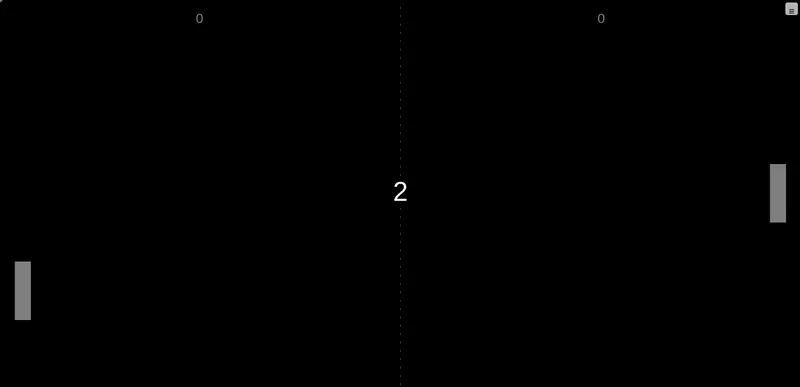TypeScript Pong
TypeScript remake of the classic Pong game with online multiplayer.

About This Project
I’ve taken the classic Pong game to the next level by adding online multiplayer functionality! This project is built using TypeScript, HTML5 Canvas, Socket.IO, and Node.js with Express. It’s a great example of how to create a real-time, interactive web game that allows players from different locations to compete against each other.
Features
- 🎮 Classic Pong Gameplay: The core mechanics of the beloved arcade game are faithfully recreated.
- 🎯 Accurate Collision Detection: The game features precise collision detection between the ball and paddles.
- 🤖 Single Player Mode with AI: Play against a challenging AI when you want to practice solo.
- 🤝 Online Multiplayer: Challenge friends or strangers to a match in real time!
- 🖥️ In-Game Menu: Pause, restart, or enter fullscreen.
- 🕹️ Responsive Controls: Play with smooth controls on both desktop (mouse) and mobile (touch).
- 🎨 Modern Design: Clean and minimalist UI that looks great on any device.
- 🔧 TypeScript: Ensures type safety and enhances code maintainability.
- 🌐 Socket.IO: Enables real-time, bidirectional communication between the server and clients.
- 🚀 Node.js & Express: Powers the backend server for matchmaking and game state synchronization.
Technical Implementation
This project showcases a robust client-server architecture for a real-time multiplayer game. Let’s break down the key components:
Client-Side (TypeScript, HTML5 Canvas)
- Object-Oriented Structure: The game logic is organized into classes like
Game,Paddle,Ball,AI,CollisionManager,ScoreManager, andRenderer. This makes the code modular and easier to understand. - Game Loop: The
Gameclass manages the main game loop, responsible for updating the game state and rendering the graphics. Here is a snippet of theGameclass:export class Game { // ... other properties ... private countdownTimer: number = 5; private isCountingDown: boolean = false; private isMultiplayer: boolean = false; private playerId: number = 0; // ... constructor and other methods ... private gameLoop() { if (this.isGameRunning) { if (!this.isPaused) { if (!this.isCountingDown) { this.update(); } this.draw(); } requestAnimationFrame(this.gameLoop.bind(this)); } } private update() { if (!this.isMultiplayer) { // Single player update logic... } else { // Multiplayer update logic... } } // ... rest of Game class ... } - Rendering: The
Rendererclass handles drawing all the game elements on the HTML5 Canvas, including a game over screen and countdown timer. - Input Handling: Event listeners capture mouse and touch events to control the player’s paddle.
- Multiplayer Integration: The
MultiplayerManagerclass handles communication with the server via Socket.IO. It listens for events likegameStart,opponentPaddleMove,ballUpdate,scoreUpdate, andopponentDisconnected.export class MultiplayerManager { // ... properties ... constructor(game: Game) { this.game = game; } public startMultiplayerGame() { this.game.setIsMultiplayer(true); this.socket = io(window.location.origin); this.setupSocketListeners(); this.socket.emit('joinGame'); } // ... other methods ... }
Server-Side (Node.js, Express, Socket.IO)
- Room Management: The
RoomManagerclass handles creating and managing game rooms. Players are placed into rooms as they join, and the server keeps track of each room’s state (players, ball position, scores).class RoomManager { private gameRooms: Map<string, GameRoom> = new Map(); // ... methods to manage rooms ... } - Socket.IO Event Handling: The server listens for client connections and handles events like
joinGame,paddleMove,ballMove,collision,ballReset, anddisconnect. - Game State Synchronization: The server is the authority on the game state. It updates the ball’s position, detects collisions, updates scores, and broadcasts these changes to the clients in the same room.
- Security Considerations: As a measure against cheating, the server only accepts collision events from the socket it designates as player 1.
- Express.js: The server uses Express.js to serve the static HTML, CSS, and JavaScript files to the clients.
Multiplayer Logic
- Matchmaking: When a player clicks “Multiplayer,” the client sends a
joinGameevent to the server. The server either places the player in an existing room with an open slot or creates a new room. Once two players are in a room, thegameStartevent is emitted, and the game begins. - Paddle Movement: When a player moves their paddle, the client sends a
paddleMoveevent to the server, which then relays the updated paddle position to the other player in the room. - Ball Synchronization: Player 1 is designated as the authority on the ball’s position. They update the ball’s position locally and emit
ballMoveevents to the server. The server then broadcasts these updates to Player 2, ensuring both clients see a consistent ball position. - Collision Handling: Only Player 1 handles collision detection. When a collision occurs, they emit a
collisionevent to the server, which updates the score and broadcasts it to both players. The server also handles theballResetevent.
Development Process
Developing this multiplayer Pong game was a challenging but rewarding experience. Here are some key takeaways from the process:
- Iterative Development: I started with a basic single-player version of Pong and then incrementally added features like AI, menus, and finally, multiplayer.
- Testing and Debugging: Real-time multiplayer introduces complexities. I used browser developer tools and server-side logging extensively to debug synchronization issues and ensure smooth gameplay.
- Learning Socket.IO: This project was my first deep dive into Socket.IO. I learned a lot about real-time communication and how to manage state in a distributed environment.
Get the Code and Play!
You can find the complete source code for this project on GitHub: GitHub Repository
Feel free to clone the repository, run it locally, and explore the code. I encourage you to experiment, add your own features, and even try to improve the AI!
Live Demo: You can also play the game live here: Live Demo
Future Enhancements
Here are some ideas for future improvements:
- Improved AI: Make the AI opponent even more challenging and adaptable.
- Power-ups: Add fun power-ups like speed boosts or multiball.
- Customization: Allow players to customize paddle colors or game settings.
- Chat: Implement in-game chat for player interaction.
- Leaderboards: Keep track of player scores and rankings.
I hope you enjoy playing and exploring this multiplayer Pong game as much as I enjoyed building it! If you have any feedback or suggestions, please feel free to reach out or open an issue on GitHub.